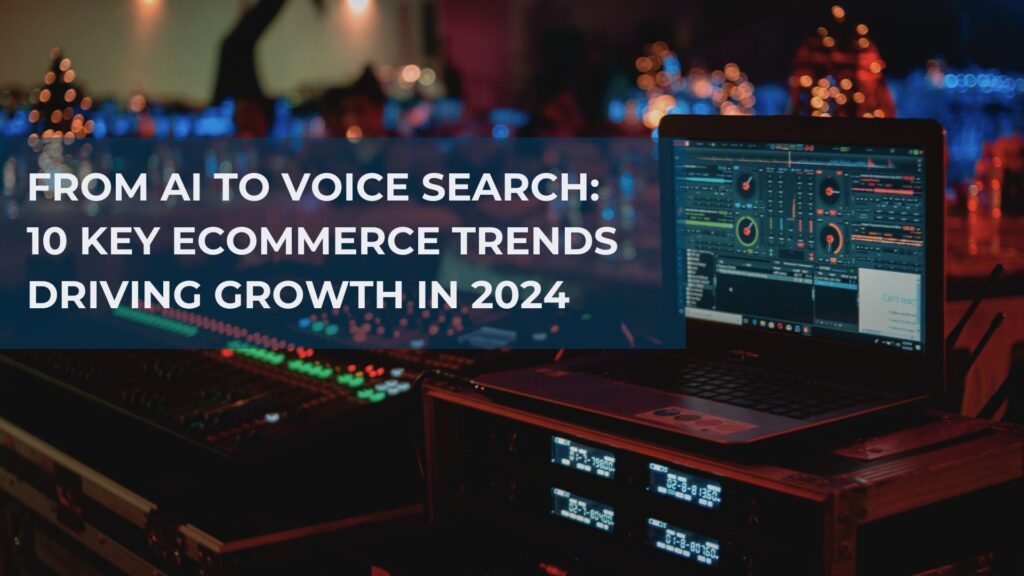From AI to Voice Search: 10 Key Ecommerce Trends Driving Growth in 2024
As we step into 2024, the trajectory for eCommerce trends in 2024 and retail businesses points toward another significant year. While it may not reach record-breaking growth, the importance of online sales remains undiminished. Recent insights indicate that approximately 62% of retailers are set to maintain or increase their investments in eCommerce technologies in the coming year, a notable contrast to the 14.3% considering cutbacks.
Now, the pivotal question arises: Where are these investments directed? What lies on the horizon as the next frontiers in eCommerce? These considerations prompt a closer examination of emerging trends and the strategic domains that demand attention.
As businesses gear up for 2024, the focus extends beyond mere survival. It transcends the question of whether to invest in eCommerce technologies but delves deeper into the specifics.
Default Value, with 14 years of expertise, stands ready to be your strategic partner in navigating the exciting trends that will define the eCommerce landscape in 2024. Specializing in Magento 2 development and offering high-quality web design and development, we bring a wealth of experience to the table, ensuring your online presence is not just established but optimized for success.
In this article, we’ll explore the most important eCommerce tech trends of 2024.
Exploring the momentum: The driving forces behind eCommerce evolution
The surging wave of online retail’s popularity is intricately tied to the continuous evolution of eCommerce technologies. The heightened convenience of digital purchases has become a driving force, propelling the global eCommerce industry toward an anticipated growth of approximately $13 trillion between 2022 and 2027.
Insider Intelligence forecasts a substantial surge in US B2B eCommerce online sales, projecting an increase from $1.9 trillion in 2023 to $2.4 trillion in 2025. This surge aligns with the escalating demands of consumers, showcasing a marked ascent in eCommerce sales. The digital landscape is now dotted with over 26.5 million eCommerce websites globally.
As the eCommerce realm advances, the convergence of physical and digital experiences accelerates, signaling a shift in consumer expectations toward innovative approaches from both traditional and online retailers. While physical stores still see foot traffic, there’s a notable increase in consumers comfortably opting for online purchases.

Unveiling the technological landscape: Anticipated trends shaping eCommerce in 2024
The landscape of technology has garnered significant interest in the first half of 2023, witnessing a notable resurgence driven by generative AI and various technological advancements. Beyond mere enthusiasm, we delve into the trends shaping the eCommerce realm, measuring their impact through metrics such as public interest, financial investments, and the generation of innovative ideas.
Connecting these online shopping trends with the technologies underpinning them, we navigate the complexities and challenges associated with each trend’s enduring impact. With global retail eCommerce sales valued at an estimated 5.7 trillion USD in 2022, a projected 56% surge is anticipated, propelling the figure beyond 8.1 trillion USD by 2026.
Join us in exploring the key trends poised to mold the trajectory of this dynamic industry in the coming years.
The unique frontier of AI in eCommerce

The versatility of AI in the current landscape extends to 101 applications, particularly within the realms of eCommerce trends and various retail spheres. From enhancing product information to optimizing work schedules, AI proves its prowess. Yet, our focus transcends the ordinary.
Leading companies are incorporating AI into customer service models, transforming them into more than just query solvers but actual online personal assistants. Zalando stands out as a prime example, introducing AI assistants that offer recommendations and assist customers in product discovery through a chat interface. Notably, this extends to personalized suggestions like recommending clothing sizes based on body measurements and photos, showcasing the unique possibilities AI brings to the online shopping experience.
This strategic integration of AI not only streamlines routine tasks but also empowers human teams to address more complex and unforeseen challenges, ensuring a harmonious balance between technological innovation and human expertise.
Unleashing the power of conversational commerce

Enter the era of “conversational commerce,” where businesses leverage chatbots, voice assistants, messaging apps, and diverse communication channels to facilitate seamless interaction and transactions with customers.
In the pursuit of a more immersive purchasing experience, customers are drawn to real-time, natural conversations that add a personalized touch to their engagement. Recognizing this shift, conversational marketing is gaining traction, offering eCommerce businesses a novel way to connect with their audience.
Empowered by chatbots or live agents, conversational marketing enables users to not only make purchases but also gather information about services in a dynamic and engaging manner. The benefits for eCommerce businesses are manifold:
1. Facilitating meaningful conversations with consumers.
2. Boosting revenue through unique proposals and enticing offers.
3. Gaining valuable customer insights and instant feedback for informed decision-making.
4. Lowering service costs by providing prompt and practical assistance.
By implementing chatbots across official websites and social media accounts, eCommerce entrepreneurs can harness the potential of conversational marketing. Whether through chatbot prompts or the integration of real operators, this approach aims to maximize customer engagement and satisfaction.
The dynamics of voice commerce
In the evolving landscape of eCommerce, Voice Commerce, often referred to as V-commerce, leverages voice-activated assistants and devices to empower customers to make purchases seamlessly through voice commands.
Voice assistants such as Google Assistant, Amazon Alexa, or Apple Siri play a pivotal role by comprehending and responding to voice instructions, conducting product searches, offering information, and even completing transactions.
This innovative approach simplifies the shopping journey by eliminating the need for typing and navigating screens. Customers can effortlessly voice their requests, like “Purchase a pair of black sneakers,” and the voice assistant takes care of the rest.
For businesses to thrive in this domain, it’s imperative to ensure that product details and content are optimized for voice searches. Smooth integration with voice assistant platforms and the implementation of secure authentication methods to prevent unauthorized purchases are also essential steps in navigating the landscape of Voice Commerce.
The composable revolution
As we delve into the realm of business evolution, the concept of composable is gaining unprecedented momentum. While it’s not entirely novel, its prominence is reaching new heights, signaling a shift away from legacy monoliths. Various philosophies and business approaches are converging on similar principles:
Composable Commerce: Businesses adopting Composable Commerce break down their processes into smaller, rearrangeable components, fostering flexibility and adaptability.
MACH Architecture: A parallel contender in the composable arena, MACH architecture, though the ‘C’ doesn’t stand for Composable, aligns with the principles of modular design.
Multiexperience and Total Experience: These trends subtly endorse composable modularity, recommending tailored solutions for each channel, be it Multiexperience or Total Experience.
While composable isn’t entirely groundbreaking, its resurgence is notable. Gartner identified Composable Commerce as a key trend in 2022, acknowledging its significance. Despite economic challenges, companies are gradually embracing modularity in their expansions, acknowledging the need for adaptability. It’s a journey, one step at a time.
And, of course, the marketing plug — if you’re considering the shift to a composable approach, we’re here to support you! Explore our Composable Commerce ebook for valuable insights and guidance in navigating this transformative path.
The MACH architecture advantage

Embracing a paradigm shift in the eCommerce landscape, MACH architecture stands as a novel approach prioritizing scalability and flexibility. Comprising four integral components, MACH architecture redefines the eCommerce platform:
- Microservices: Breaking away from monolithic structures, MACH divides the eCommerce platform into autonomous microservices. This restructuring simplifies the development, implementation, and scalability of the platform.
- API-First Approach: MACH architecture adopts an API-first approach, leveraging APIs to expose microservices. This seamless integration allows easy collaboration with various systems, including marketing automation and CRM.
- Cloud-Native: Harnessing the power of cloud computing platforms, MACH architecture ensures scalability and robustness. The platform effortlessly adjusts its scale and recovers from disruptions, thanks to its cloud-native design.
- Headless: Distinctly separating the front-end display layer from back-end commerce functionality, MACH architecture streamlines the delivery of information and user experiences across diverse touchpoints, including websites, mobile applications, and the Internet of Things.
Businesses venturing into the online selling domain can unlock several advantages with MACH architecture:
- Faster Time to Market: MACH architecture facilitates the swift development and implementation of new features, expediting a business’s time-to-market.
- Increased Agility: Adapting to market changes becomes seamless with MACH architecture, allowing businesses to stay ahead in the competitive landscape.
- Enhanced Scalability: The scalable nature of MACH architecture empowers companies to adjust the platform’s scale rapidly as per their evolving needs.
Sustainable choices: The evolution of consumer responsibility

The landscape of consumer consciousness has undergone a significant transformation in recent years. Today’s shoppers not only seek responsible product choices but also actively align themselves with brands committed to ethical practices.
This shift is evident in the market, where products backed by Environmental, Social, and Governance (ESG) claims exhibit a cumulative growth of 28%, surpassing the 20% growth of their counterparts without such credentials. The message from consumers is clear — responsible choices matter.
Anticipating further strides in this direction, we envisage a future where sustainability extends beyond conventional ESG reports and declarations. As green initiatives continue to proliferate globally, consumers will come to expect sustainable attributes as standard information for all products. The journey toward responsible consumption is unfolding, and the demand for transparency and eco-friendly practices is more pronounced than ever.
The future of personalized shopping
The advent of eCommerce has revolutionized the shopping landscape, prompting us to ponder the future of this dynamic industry. As we navigate the ever-evolving trends shaping our buying experiences, several notable developments stand out:
Advanced Customer Analytics: Businesses are leveraging sophisticated customer analytics to gain unprecedented insights into the preferences and needs of their customers. This wealth of data is fueling the creation of highly personalized and engaging shopping experiences tailored to individual preferences.
Personalized Sensory Experiences: Retailers are extending personalization beyond visuals to include sensory elements such as scents and sounds. Creating multi-dimensional and immersive shopping environments, these sensory cues enhance the overall experience. For instance, a clothing store may synchronize a specific scent with its displayed attire, complementing the overall ambiance.
Digital Self-Representations: The rise of digital mannequins introduces a new dimension to personalized shopping. Customers can now interact with digital representations of themselves, selecting the ideal fit and style. Equipped with sensors, these digital avatars monitor customers’ body dimensions and preferences, ensuring a tailored and convenient shopping journey.
The future of eCommerce is undoubtedly shaped by these innovative trends, promising a more personalized, engaging, and sensory-rich shopping experience for consumers.
The role of natural language processing

In the pursuit of realizing the potential of AI-driven customer service and hyper-personalized stores, one pivotal aspect comes into play: Natural Language Processing (NLP).
For the vision of these transformative eCommerce trends to materialize, businesses require automated processes adept at comprehending and responding to customer queries effectively.
NLP serves as the linchpin, facilitating the adoption of semantic search capabilities. This empowers customers to search effortlessly, without the need to meticulously phrase queries for search engines. It marks a significant stride toward harnessing the essence of human-to-human interactions in the realm of digital channels. The integration of NLP is a key enabler for more intuitive and seamless eCommerce engagements.
The power of visual search
In the realm of technology-driven shopping experiences, Visual Search has emerged as a game-changer. While tech-savvy users have long utilized Google reverse image searches, recent advancements, particularly Google’s Multitask Unified Model algorithm (MUM), have elevated the eCommerce journey.
With MUM, shoppers can now upload an image of the desired item, and the search engine will present a diverse array of similar products available for purchase. The seamless integration of MUM with Google Lens ensures a streamlined and efficient visual product search experience.
For eCommerce businesses aligning with visual search, optimizing images and product descriptions to meet MUM’s standards is crucial. This optimization not only enhances search engine rankings but also facilitates direct purchases.
Leading eCommerce platforms are recognizing the significance of visual search, offering features that can be seamlessly integrated into websites and mobile apps. Platforms like Shopify provide applications such as Visual Search, while Magento offers the Product Search Via Image Extension, empowering businesses to stay at the forefront of this transformative trend.
The rise of hybrid retail
Navigating the retail landscape undergoes a profound transformation with the evolution of Hybrid Retail. This innovative approach seamlessly integrates online and offline channels within the eCommerce domain. The surge in the significance of platform choice plays a pivotal role in shaping in-store technology selection.
As businesses increasingly embrace direct-to-consumer (DTC) eCommerce models, they concurrently invest in physical retail spaces. The aim is to deliver immersive and personalized shopping experiences that transcend the boundaries of digital interaction.
The Hybrid Retail model not only bridges the gap between virtual and physical realms but also unlocks the potential for businesses to harness data from both channels. This dual-channel strategy empowers businesses with comprehensive insights into customer behavior and preferences, fostering a more nuanced understanding that propels the retail experience into a new era of connectivity and engagement.
The bottom line
In conclusion, the landscape of eCommerce in 2024 is marked by dynamic trends that redefine the way businesses connect with consumers. From the integration of AI-powered solutions to the evolution of MACH architecture, the industry is poised for innovation and adaptability. Environmental sustainability, personalized shopping experiences, and the seamless fusion of online and offline channels through hybrid retail are shaping a future where customer-centricity is paramount.
As businesses navigate this landscape, staying ahead with cutting-edge technologies and strategies becomes crucial. With 14 years of expertise in eCommerce, Default Value stands as a reliable partner, offering tailored solutions to meet the evolving demands of this dynamic industry. The journey into 2024 promises not just advancements but a new era of consumer engagement and business success. Contact us to kick off 2024 with a revolution in your online store.




